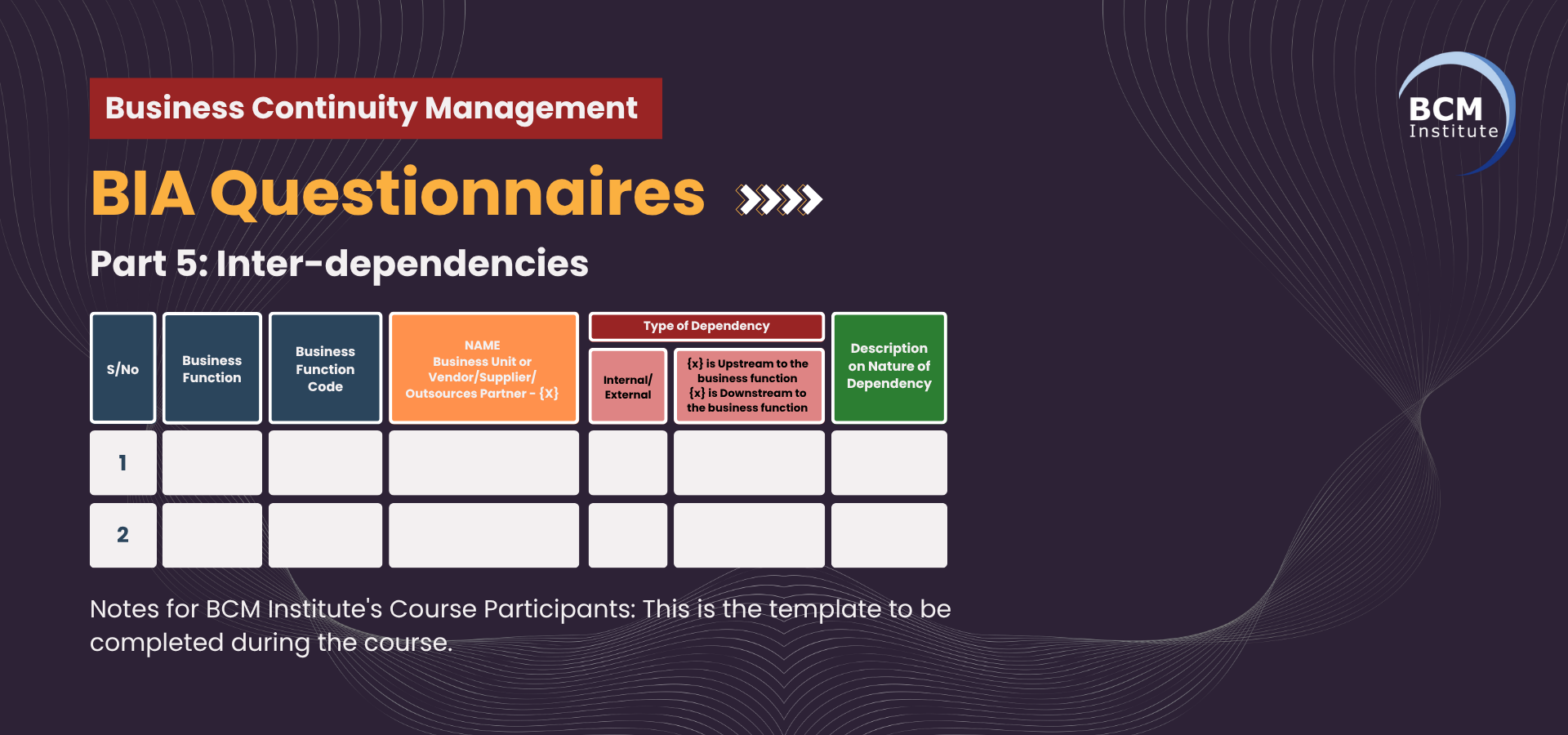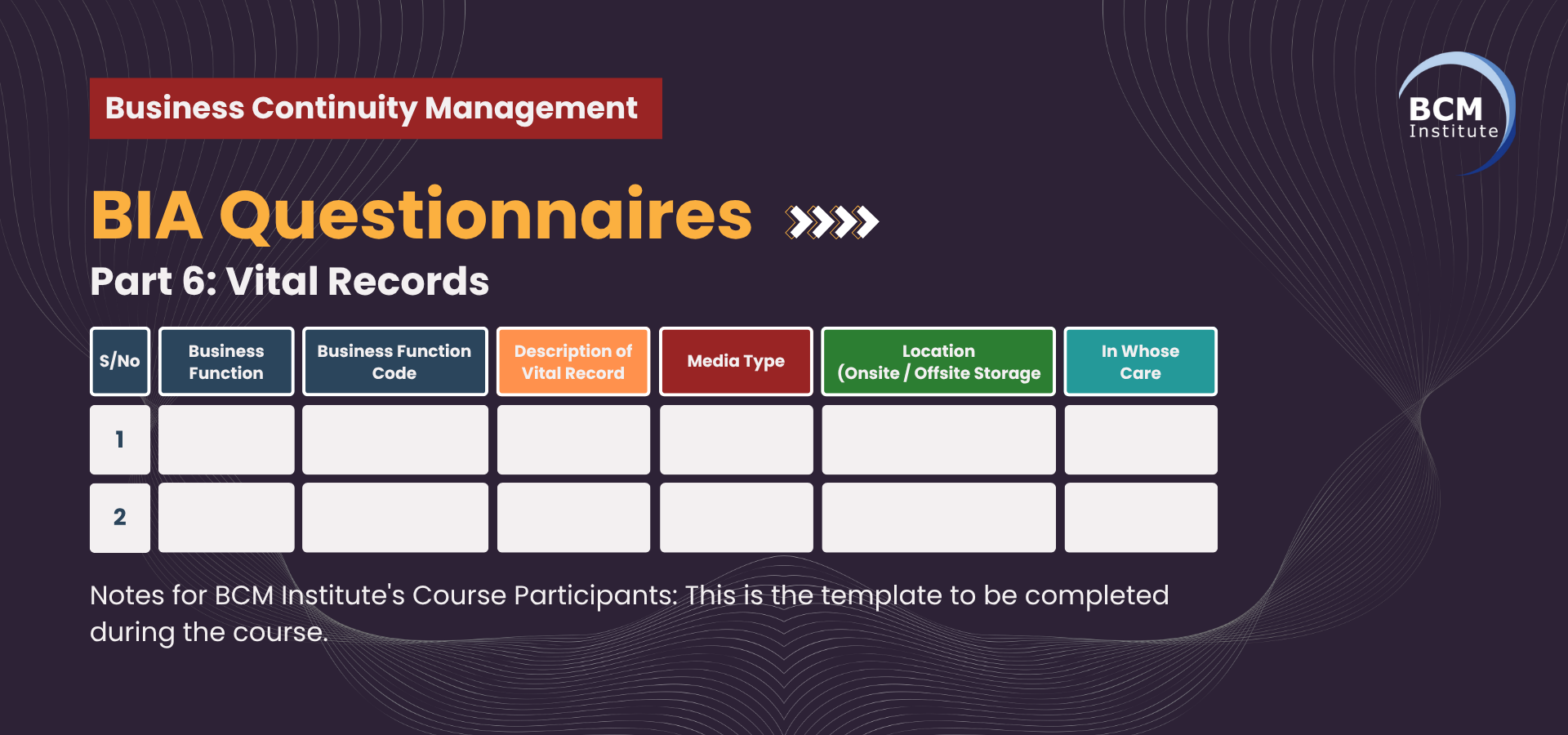[Business Impact Analysis] [Critical Business Function] [T3] Part 5

Part 5: Inter-dependencies
CBF-1: Labour Market Regulation and Enforcement
Effective execution of labour market regulation and enforcement requires the Ministry of Manpower (MOM) to operate within a highly interconnected ecosystem.
Each sub-critical business function (Sub-CBF) depends on both internal and external partners to ensure timely and accurate outcomes. These inter-dependencies may be upstream (providing inputs to the Sub-CBF), downstream (receiving outputs from the Sub-CBF), or mutual (where collaboration is continuous and reciprocal).
By mapping these inter-dependencies, MOM can better understand vulnerabilities across its value chain, strengthen resilience against disruptions, and ensure coordinated crisis response. The table below highlights the inter-dependencies associated with each Sub-CBF.
Table 5: Inter-dependencies of Sub-CBFs for CBF-1
|
Sub-CBF Code |
Sub-CBF |
Name of Business Unit / Vendor / Supplier / Outsource Partner |
Type of Dependency – Internal |
Type of Dependency – External |
Dependency Direction (Upstream / Downstream / Mutual) |
Description of Nature of Dependency |
|
1.1 |
Policy & Regulation Design |
Policy & Planning Division, Legal Services |
✔ |
Inputs from Tripartite Partners (NTUC, SNEF), International Labour Organisation (ILO) |
Upstream |
Internal divisions provide legal and strategic guidance, while external partners contribute international standards and labour market feedback shaping MOM’s policies. |
|
1.2 |
Licensing & Permits |
Work Pass Division, IT Application Vendor (WP Online) |
✔ |
Employers, Employment Agencies, IT service providers |
Mutual |
Internal units manage approvals while external employers/agencies submit applications. IT vendors ensure system uptime for continuous operations. |
|
1.3 |
Inspections, Monitoring & Investigation |
Foreign Manpower Management Division, Occupational Safety and Health Division |
✔ |
External contractors, employers, migrant worker dormitory operators |
Upstream & Downstream |
Internal units supply inspection protocols and coordination, while external employers provide access and compliance data. Findings flow downstream for enforcement. |
|
1.4 |
Adjudication & Dispute Resolution |
Labour Relations & Workplaces Division |
✔ |
Industrial Arbitration Court, Tripartite Alliance for Dispute Management (TADM) |
Mutual |
Internal divisions coordinate dispute handling, while external arbitration and mediation bodies provide final resolution mechanisms. |
|
1.5 |
Enforcement Actions & Sanctions |
Foreign Manpower Management Division (Enforcement Branch), Legal Services |
✔ |
Law enforcement agencies, Judiciary |
Downstream |
MOM initiates enforcement actions internally; external agencies (police, courts) execute legal proceedings and sanctions. |
|
1.6 |
Stakeholder Engagement & Education |
Communications & Engagement Department, Tripartite Alliance for Fair & Progressive Employment Practices (TAFEP) |
✔ |
Employers’ Federations, Worker Unions, NGOs, Media Partners |
Mutual |
MOM provides policies and guidance internally, while external stakeholders amplify communication, promote compliance, and provide feedback loops. |
|
1.7 |
Regulatory Intelligence & Risk Management |
Policy & Strategy Division, Manpower Research & Statistics Department |
✔ |
External data providers, research institutions, and international labour agencies |
Upstream |
Internal analytics functions integrate regulatory intelligence, while external data sources and institutions provide essential labour market insights. |
Summing Up … for Part 5
The inter-dependencies identified across MOM’s Labour Market Regulation and Enforcement function demonstrate that resilience is not confined to internal operations alone.
Rather, it extends into partnerships with external agencies, industry stakeholders, and international bodies. Understanding these interconnections enables MOM to anticipate cascading effects from disruptions, implement more effective contingency measures, and strengthen collaboration with partners.
A robust inter-dependency framework ensures that MOM’s role in safeguarding fair and progressive employment practices, maintaining workforce safety, and enforcing labour laws remains uninterrupted even in times of crisis.
[Business Impact Analysis] [Critical Business Function] [T3] Part 6

Part 6: Vital Records
CBF-1: Labour Market Regulation and Enforcement
![[BCM] [MOM] [E3] [BIA] [T3] [CBF] [1] Labour Market Regulation and Enforcement](https://no-cache.hubspot.com/cta/default/3893111/bbc0c267-3d28-497d-9504-5d1853058e7b.png)
Vital records are essential documents, data, and information assets that must be preserved to ensure the Ministry of Manpower (MOM) can continue performing its critical business function CBF-1: Labour Market Regulation and Enforcement, even during and after a disruption.
These records provide the legal, regulatory, operational, and historical foundation for policy enforcement, dispute resolution, licensing, and compliance monitoring.
The Ministry of Manpower relies on accurate, secure, and accessible vital records to safeguard its role in regulating Singapore’s labour market.
As such, these records must be properly identified, stored, and managed to guarantee their availability when needed, thereby maintaining public trust and compliance with statutory obligations.
Table 6: Vital Records of Sub-CBFs for CBF-1
|
Sub-CBF Code |
Sub-CBF |
Description of Vital Records |
Media Type |
Location |
In Whose Care |
|
1.1 |
Policy & Regulation Design |
Legislative documents, ministerial directives, regulatory frameworks, and policy drafts |
Digital (document management systems), Hardcopy (legal archives) |
MOM HQ – Policy Division; National Archives (for historical records) |
Director, Policy & Regulation Division |
|
1.2 |
Licensing & Permits |
Approved work passes, permits, licensing applications, databases of employers/employees, and decision records |
Digital databases, Hardcopy application records |
Work Pass Division Data Centre; Offsite backup facility |
Divisional Head, Licensing & Permits |
|
1.3 |
Inspections, Monitoring & Investigation |
Inspection reports, monitoring logs, investigation case files, and evidence records |
Digital case management system, Hardcopy (sealed evidence files) |
MOM Inspection & Investigation Unit Repository |
Chief Inspector |
|
1.4 |
Adjudication & Dispute Resolution |
Case files, tribunal records, arbitration decisions, appeals documentation |
Digital case management system, Hardcopy (legal documents) |
MOM Adjudication Division Records Office |
Registrar of Labour Tribunals |
|
1.5 |
Enforcement Actions & Sanctions |
Enforcement orders, penalty records, prosecution files, sanctions database |
Digital enforcement system, Hardcopy (court submissions) |
MOM Enforcement Division & Legal Unit |
Director, Enforcement Division |
|
1.6 |
Stakeholder Engagement & Education |
Communication records, training materials, public advisories, stakeholder feedback |
Digital repositories (website CMS, learning systems), Hardcopy publications |
MOM Communications & Engagement Department |
Head, Stakeholder Engagement |
|
1.7 |
Regulatory Intelligence & Risk Management |
Risk assessment reports, regulatory intelligence data, trend analyses, risk registers |
Digital databases, Hardcopy (confidential reports) |
MOM Risk Management Unit & Secure Servers |
Chief Risk Officer |
Summing Up … for Part 6
The identification and protection of vital records within the Ministry of Manpower’s Labour Market Regulation and Enforcement function are central to the continuity of operations.
These records serve not only as the backbone of MOM’s regulatory authority but also as the evidence base for enforcement, adjudication, and policy decisions.
By safeguarding both digital and hardcopy records, assigning custodianship to designated officers, and ensuring that secure locations and backup mechanisms are in place, MOM enhances its resilience against operational disruptions.
Ultimately, the management of vital records ensures the Ministry can uphold its mandate to maintain a fair, progressive, and regulated labour market in Singapore, even in times of crisis.
More Information About Business Continuity Management Courses
To learn more about the course and schedule, click the buttons below for the BCM-300 Business Continuity Management Implementer [BCM-3] and the BCM-5000 Business Continuity Management Expert Implementer [BCM-5].





![[BCM] [MOM] [E3] [BIA] MBCO Corporate MBCO](https://no-cache.hubspot.com/cta/default/3893111/91c07ac1-2f4d-4acf-a002-df50ac7e8f19.png)
![[BCM] [MOM] [E3] [BIA] [P&S] Key Product and Services](https://no-cache.hubspot.com/cta/default/3893111/904a4659-6e74-4f50-a27d-b0543463d80a.png)
![[BCM] [MOM] [E3] [RAR] [T1] List of Threats](https://no-cache.hubspot.com/cta/default/3893111/41c8981e-45dd-416c-90e0-55c3a22753da.png)
![[BCM] [MOM] [E3] [RAR] [T2] Treatment and Control](https://no-cache.hubspot.com/cta/default/3893111/02909b01-2511-4249-864b-967afcc727bc.png)
![[BCM] [MOM] [E3] [RAR] [T3] Risk Impact and Likelihood Assessmen](https://no-cache.hubspot.com/cta/default/3893111/fd3dd074-a74d-45ec-8219-3cee4c0463c4.png)
![[BCM] [MOM] [E3] [BCS] [T1] Mitigation Strategies and Justification](https://no-cache.hubspot.com/cta/default/3893111/06674b8b-3cf9-4855-a89a-ecd2baa9a395.png)
![[BCM] [MOM] [E1] [C10] Identifying Critical Business Functions](https://no-cache.hubspot.com/cta/default/3893111/f19dbb07-448c-4021-9605-82ad98643d7f.png)
![[BCM] [MOM] [E3] [BIA] [DP] [CBF] [1] Labour Market Regulation and Enforcement](https://no-cache.hubspot.com/cta/default/3893111/ff0a9479-fa3e-41a8-ba7b-9d151a715d05.png)
![[BCM] [MOM] [E3] [BIA] [T1] [CBF] [1] Labour Market Regulation and Enforcement](https://no-cache.hubspot.com/cta/default/3893111/6eaa5c4f-0bd6-4343-85a8-d94449364aa5.png)
![[BCM] [MOM] [E3] [BIA] [T2] [CBF] [1] Labour Market Regulation and Enforcement](https://no-cache.hubspot.com/cta/default/3893111/bcb5337e-1bdd-47dc-b0af-399dfc78021a.png)
![[BCM] [MOM] [E3] [BCS] [T2] [CBF] [1] Recovery Strategies](https://no-cache.hubspot.com/cta/default/3893111/c295a198-de84-41b2-be64-0a5d39bf87fe.png)
![[BCM] [MOM] [E3] [BCS] [T3] [CBF] [1] Minimum Resources Required during a Disaster](https://no-cache.hubspot.com/cta/default/3893111/68673062-6e5b-4e51-9226-4da013aaaa0e.png)
![[BCM] [MOM] [E3] [PD] [CBF] [1] Labour Market Regulation and Enforcement](https://no-cache.hubspot.com/cta/default/3893111/2ef54310-5f33-42cd-874b-187f278267ee.png)


![Register [BL-B-3]*](https://no-cache.hubspot.com/cta/default/3893111/ac6cf073-4cdd-4541-91ed-889f731d5076.png)



![FAQ [BL-B-3]](https://no-cache.hubspot.com/cta/default/3893111/b3824ba1-7aa1-4eb6-bef8-94f57121c5ae.png)
![Email to Sales Team [BCM Institute]](https://no-cache.hubspot.com/cta/default/3893111/3c53daeb-2836-4843-b0e0-645baee2ab9e.png)





